冀教版小学英语第五册第三单元教材分析与教学设计
- 格式:doc
- 大小:53.50 KB
- 文档页数:11
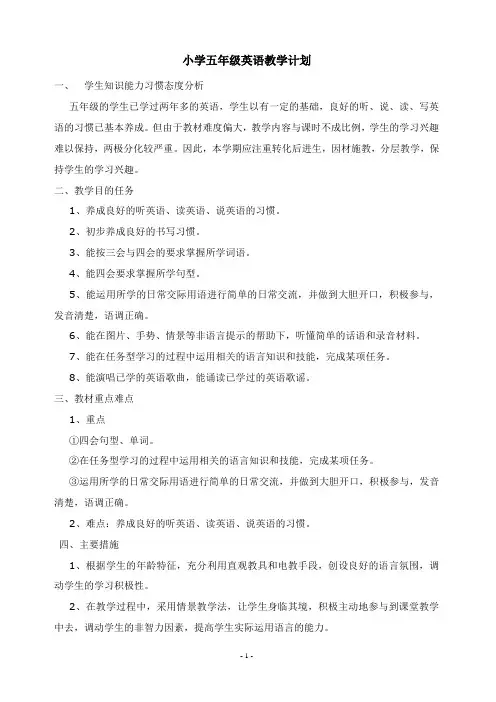
小学五年级英语教学计划一、学生知识能力习惯态度分析五年级的学生已学过两年多的英语,学生以有一定的基础,良好的听、说、读、写英语的习惯已基本养成。
但由于教材难度偏大,教学内容与课时不成比例,学生的学习兴趣难以保持,两极分化较严重。
因此,本学期应注重转化后进生,因材施教,分层教学,保持学生的学习兴趣。
二、教学目的任务1、养成良好的听英语、读英语、说英语的习惯。
2、初步养成良好的书写习惯。
3、能按三会与四会的要求掌握所学词语。
4、能四会要求掌握所学句型。
5、能运用所学的日常交际用语进行简单的日常交流,并做到大胆开口,积极参与,发音清楚,语调正确。
6、能在图片、手势、情景等非语言提示的帮助下,听懂简单的话语和录音材料。
7、能在任务型学习的过程中运用相关的语言知识和技能,完成某项任务。
8、能演唱已学的英语歌曲,能诵读已学过的英语歌谣。
三、教材重点难点1、重点①四会句型、单词。
②在任务型学习的过程中运用相关的语言知识和技能,完成某项任务。
③运用所学的日常交际用语进行简单的日常交流,并做到大胆开口,积极参与,发音清楚,语调正确。
2、难点:养成良好的听英语、读英语、说英语的习惯。
四、主要措施1、根据学生的年龄特征,充分利用直观教具和电教手段,创设良好的语言氛围,调动学生的学习积极性。
2、在教学过程中,采用情景教学法,让学生身临其境,积极主动地参与到课堂教学中去,调动学生的非智力因素,提高学生实际运用语言的能力。
3、活用教材,根据学生会的实际情况,将每单元各个板块重现组排降低难度。
教学进度表周次日期教学内容页码备注第 1周8/27--8/29 Lesson1第 2周8/31--9/5 Lesson2,3第 3周9/7--9/12 Lesson4,5第 4周9/14-9/19 Lesson6,7,8第 5周9/21--9/26 Lesson9,10第6周9/28---10/3 Lesson11第 7周10/5--10/10 Lesson12,13第 8周10/12--10/17 Lesson14,15,16第 9周10/19--10/24 Lesson17,18第 10周 10/26---10/31第 11周11/2--11/7第 12周11/9--11/14 Lesson19,20第 13周11/16--11/21 Lesson21,22第 14周11/23--11/28 Lesson23,24,25第 15周11/30---12/5 Lesson26,27第 16周12/7--12/12 Lesson28,29第 17周12/14--12/19 Lesson30,31第 18周12/21--12/26第 19周12/28---1/2第 20周1/4--1/9Lesson 1: Fathers Mothers Brothers and Sisters教学目标:知识与技能:在本课中,孩子们掌握并能充分运用家庭成员的词语,例如 father mother son daughter grandfather grandmother brother and sister.能够准确的理解并练习 older younger ,并在原有基础上做“举一反三”练习。
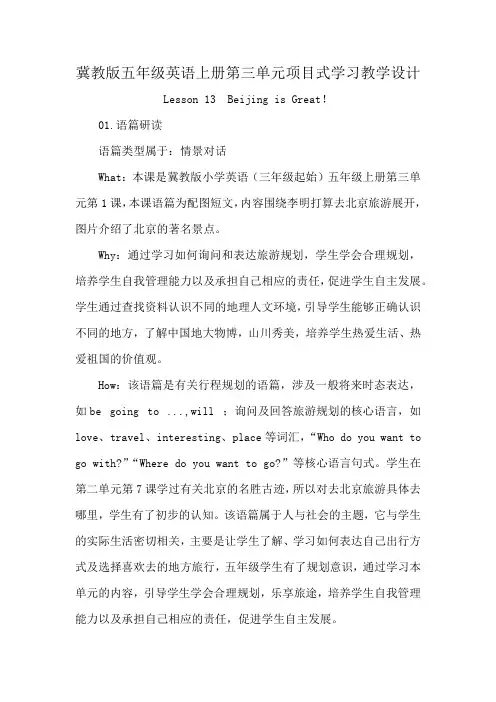
冀教版五年级英语上册第三单元项目式学习教学设计Lesson 13 Beijing is Great!01.语篇研读语篇类型属于:情景对话What:本课是冀教版小学英语(三年级起始)五年级上册第三单元第1课,本课语篇为配图短文,内容围绕李明打算去北京旅游展开,图片介绍了北京的著名景点。
Why:通过学习如何询问和表达旅游规划,学生学会合理规划,培养学生自我管理能力以及承担自己相应的责任,促进学生自主发展。
学生通过查找资料认识不同的地理人文环境,引导学生能够正确认识不同的地方,了解中国地大物博,山川秀美,培养学生热爱生活、热爱祖国的价值观。
How:该语篇是有关行程规划的语篇,涉及一般将来时态表达,如be going to ...,will ;询问及回答旅游规划的核心语言,如love、travel、interesting、place等词汇,“Who do you want to go with?”“Where do you want to go?”等核心语言句式。
学生在第二单元第7课学过有关北京的名胜古迹,所以对去北京旅游具体去哪里,学生有了初步的认知。
该语篇属于人与社会的主题,它与学生的实际生活密切相关,主要是让学生了解、学习如何表达自己出行方式及选择喜欢去的地方旅行,五年级学生有了规划意识,通过学习本单元的内容,引导学生学会合理规划,乐享旅途,培养学生自我管理能力以及承担自己相应的责任,促进学生自主发展。
02.学情分析已有生活经验:五年级的学生接触英语已经两年多了,他们对英语学习有了一定的了解并积累了一定的知识基础,有了初步的语言交际能力。
本课利用五年级学生活泼、好动、易于接受和模仿,有效注意时间短的特点,通过情景教学、角色扮演、小组调查和报告等方式延长学生的有效注意时间,激发学生学习英语的兴趣,达到有效教学,培养学生乐观自信的态度。
已有知识储备:通过第一单元的学习,学生可以用英语表达自己的意愿。
通过第二单元的学习,学生对说英语的6个国家有名地方和中国北京有了初步的了解,学生对旅行之旅充满了期待。

小学五年级英语教学计划一、学生知识能力习惯态度分析五年级的学生已学过两年多的英语,学生以有一定的基础,良好的听、说、读、写英语的习惯已基本养成。
但由于教材难度偏大,教学内容与课时不成比例,学生的学习兴趣难以保持,两极分化较严重。
因此,本学期应注重转化后进生,因材施教,分层教学,保持学生的学习兴趣。
二、教学目的任务1、养成良好的听英语、读英语、说英语的习惯。
2、初步养成良好的书写习惯。
3、能按三会与四会的要求掌握所学词语。
4、能四会要求掌握所学句型。
5、能运用所学的日常交际用语进行简单的日常交流,并做到大胆开口,积极参与,发音清楚,语调正确。
6、能在图片、手势、情景等非语言提示的帮助下,听懂简单的话语和录音材料。
7、能在任务型学习的过程中运用相关的语言知识和技能,完成某项任务。
8、能演唱已学的英语歌曲,能诵读已学过的英语歌谣。
三、教材重点难点1、重点①四会句型、单词。
②在任务型学习的过程中运用相关的语言知识和技能,完成某项任务。
③运用所学的日常交际用语进行简单的日常交流,并做到大胆开口,积极参与,发音清楚,语调正确。
2、难点:养成良好的听英语、读英语、说英语的习惯。
四、主要措施1、根据学生的年龄特征,充分利用直观教具和电教手段,创设良好的语言氛围,调动学生的学习积极性。
2、在教学过程中,采用情景教学法,让学生身临其境,积极主动地参与到课堂教学中去,调动学生的非智力因素,提高学生实际运用语言的能力。
3、活用教材,根据学生会的实际情况,将每单元各个板块重现组排降低难度。
教学进度表周次日期教学内容页码备注第 1周8/27--8/29 Lesson1第 2周8/31--9/5 Lesson2,3第 3周9/7--9/12 Lesson4,5第 4周9/14-9/19 Lesson6,7,8第 5周9/21--9/26 Lesson9,10第6周9/28---10/3 Lesson11第 7周10/5--10/10 Lesson12,13第 8周10/12--10/17 Lesson14,15,16第 9周10/19--10/24 Lesson17,18第 10周 10/26---10/31第 11周11/2--11/7第 12周11/9--11/14 Lesson19,20第 13周11/16--11/21 Lesson21,22第 14周11/23--11/28 Lesson23,24,25第 15周11/30---12/5 Lesson26,27第 16周12/7--12/12 Lesson28,29第 17周12/14--12/19 Lesson30,31第 18周12/21--12/26第 19周12/28---1/2第 20周1/4--1/9Lesson 1: Fathers Mothers Brothers and Sisters教学目标:知识与技能:在本课中,孩子们掌握并能充分运用家庭成员的词语,例如 father mother son daughter grandfather grandmother brother and sister.能够准确的理解并练习 older younger ,并在原有基础上做“举一反三”练习。
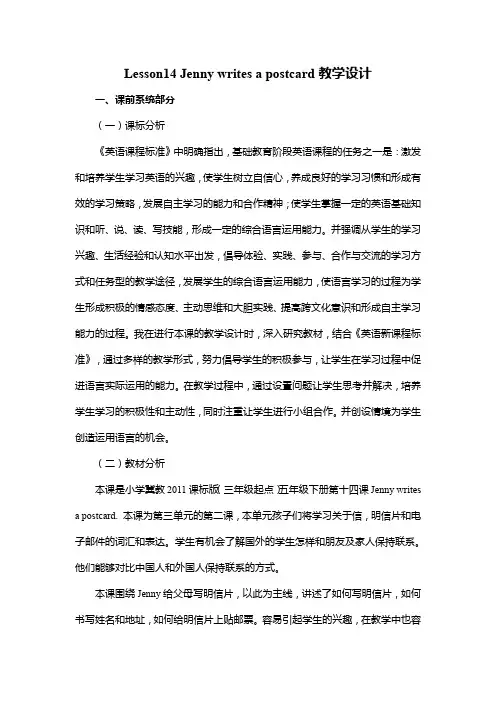
Lesson14 Jenny writes a postcard教学设计一、课前系统部分(一)课标分析《英语课程标准》中明确指出,基础教育阶段英语课程的任务之一是:激发和培养学生学习英语的兴趣,使学生树立自信心,养成良好的学习习惯和形成有效的学习策略,发展自主学习的能力和合作精神;使学生掌握一定的英语基础知识和听、说、读、写技能,形成一定的综合语言运用能力。
并强调从学生的学习兴趣、生活经验和认知水平出发,倡导体验、实践、参与、合作与交流的学习方式和任务型的教学途径,发展学生的综合语言运用能力,使语言学习的过程为学生形成积极的情感态度、主动思维和大胆实践、提高跨文化意识和形成自主学习能力的过程。
我在进行本课的教学设计时,深入研究教材,结合《英语新课程标准》,通过多样的教学形式,努力倡导学生的积极参与,让学生在学习过程中促进语言实际运用的能力。
在教学过程中,通过设置问题让学生思考并解决,培养学生学习的积极性和主动性,同时注重让学生进行小组合作。
并创设情境为学生创造运用语言的机会。
(二)教材分析本课是小学冀教2011课标版(三年级起点)五年级下册第十四课Jenny writes a postcard. 本课为第三单元的第二课,本单元孩子们将学习关于信,明信片和电子邮件的词汇和表达。
学生有机会了解国外的学生怎样和朋友及家人保持联系。
他们能够对比中国人和外国人保持联系的方式。
本课围绕Jenny给父母写明信片,以此为主线,讲述了如何写明信片,如何书写姓名和地址,如何给明信片上贴邮票。
容易引起学生的兴趣,在教学中也容易产生共鸣和互动。
本课需要学生重点掌握的是如何写一封明信片,因此在学生自主合作以及展示模块写明信片占比重较大。
通过本课的学习,不仅能增进学生对中西方文化的认识,还能使学生了解,明信片不仅仅是一张张漂亮的风景,也承载着对亲人和朋友的思念。
(三)学生分析1. 五年级的学生已经具备了一定的听、说、读、写能力,掌握了一定的英语词汇,具有一定的英语学习的积极性与主动性,具备了一定的英语语言的运用能力,大部分学生能够用简单的英语进行话题的讨论。
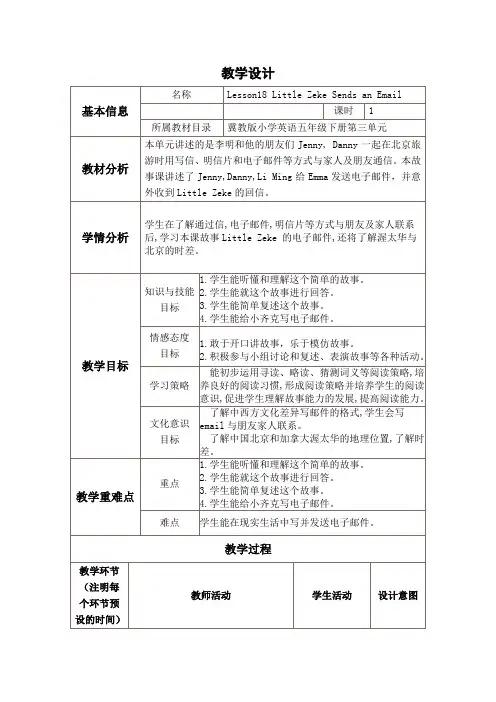
教学设计Writing (6分钟) Teacher evaluates the studentsI want to send an email to LittleZeke. Can you help me?Pay attentionTeacher evaluates the studentsWriteShow利用写邮件考察学生能正确的书写邮件的能力。
Summary (3分钟)1.How many ways do you contact with yourfriends?2.Keep in touch with your friends常和朋友保持联系3.Evaluation of students at different levelsHomework (1分钟)1. Retell the story to your friends.2. Send an email to me.板书设计L esson18 Little Zeke Sends an Email反思:在开展阅读教学时,让学生通过故事阅读掌握大量的阅读技巧,会极大地降低阅读教学难度,提高学生的阅读理解和推理能力。
英语教师要不断革新自己的教学思路,创新教学方法,采用灵活多样的教学策略,提高小学英语故事阅读教学的有效性。
本节课我从听读说写四个方面进行设计,指导学生在读前读中读后运用不同的阅读策略进行学习,比如我让学生通过寻读、略读、猜测词义、设疑引导下文等阅读策略,培养学生的阅读意识,促进学生理解故事能力的发展,提高阅读能力。
本节课目标基本达成。
本节课亮点有:1.在阅读的准备环节,我向学生简单地介绍故事发生的背景,从而引导学生进入到相应的故事情境当中,另外通过阅读准备工作能够让学生为阅读当中的词汇和重点句型语法的学习做好知识准备,从而提高阅读效率。
2.我设计了较为科学合理的阅读问题。
在提出的阅读问题尽量是需要学生通过观察思考才能解决的,并且要从整体上保证难易适当和层次清楚让学生理解文字的实际含义,让学生通过想象和深入挖掘理解来获得答案,拓展思维。
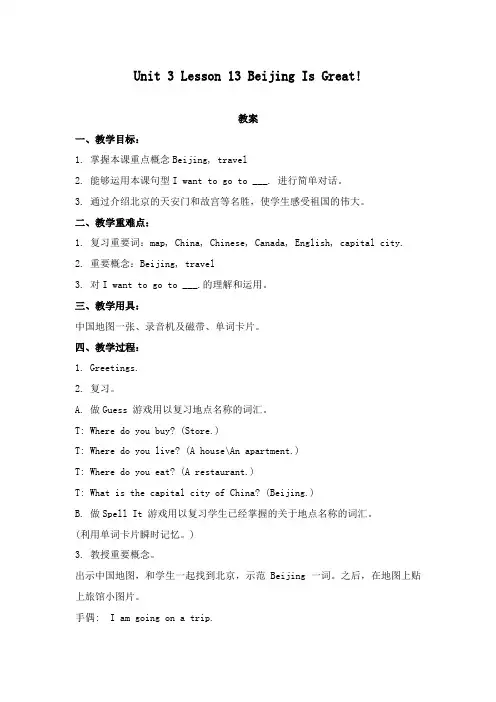
Unit 3 Lesson 13 Beijing Is Great!教案一、教学目标:1. 掌握本课重点概念Beijing, travel2. 能够运用本课句型I want to go to ___. 进行简单对话。
3. 通过介绍北京的天安门和故宫等名胜,使学生感受祖国的伟大。
二、教学重难点:1. 复习重要词:map, China, Chinese, Canada, English, capital city.2. 重要概念:Beijing, travel3. 对I want to go to ___.的理解和运用。
三、教学用具:中国地图一张、录音机及磁带、单词卡片。
四、教学过程:1. Greetings.2. 复习。
A. 做Guess 游戏用以复习地点名称的词汇。
T: Where do you buy? (Store.)T: Where do you live? (A house\An apartment.)T: Where do you eat? (A restaurant.)T: What is the capital city of China? (Beijing.)B. 做Spell It 游戏用以复习学生已经掌握的关于地点名称的词汇。
(利用单词卡片瞬时记忆。
)3. 教授重要概念。
出示中国地图,和学生一起找到北京,示范Beijing 一词。
之后,在地图上贴上旅馆小图片。
手偶: I am going on a trip.教师: Where are you going?手偶: I am going to ___.(目的地名称)教师: Do you live in ___? (目的地名称)手偶: No! I live in ___.(所在城市名称) I live in a house/an apartment. 教师: Do you have a house in ___? (目的地)手偶: No! I go to a hotel! Here I go! I want to go to___.4. 与学生一起讨论有关北京的图片。
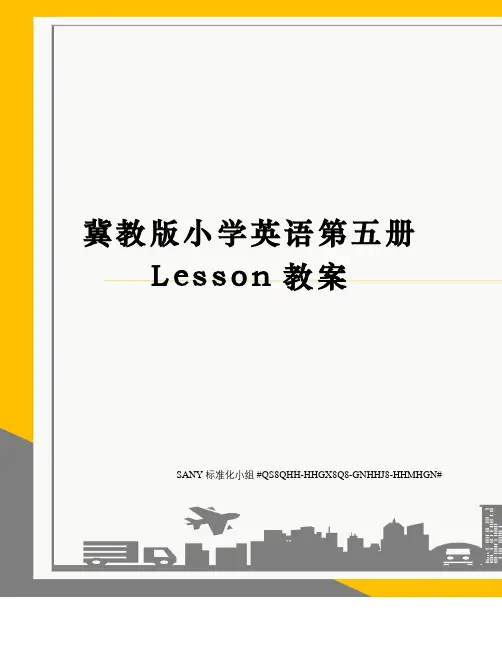
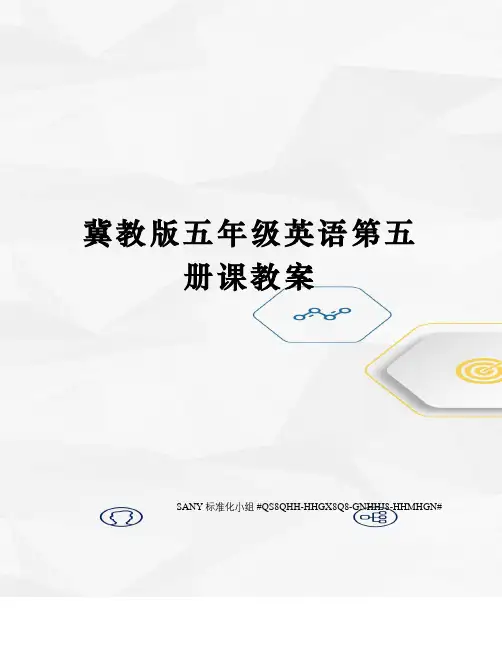
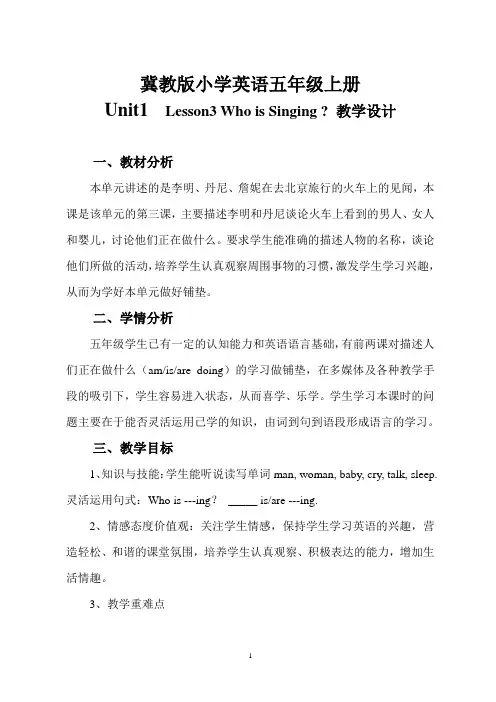
冀教版小学英语五年级上册Unit1 Lesson3 Who is Singing ? 教学设计一、教材分析本单元讲述的是李明、丹尼、詹妮在去北京旅行的火车上的见闻,本课是该单元的第三课,主要描述李明和丹尼谈论火车上看到的男人、女人和婴儿,讨论他们正在做什么。
要求学生能准确的描述人物的名称,谈论他们所做的活动,培养学生认真观察周围事物的习惯,激发学生学习兴趣,从而为学好本单元做好铺垫。
二、学情分析五年级学生已有一定的认知能力和英语语言基础,有前两课对描述人们正在做什么(am/is/are doing)的学习做铺垫,在多媒体及各种教学手段的吸引下,学生容易进入状态,从而喜学、乐学。
学生学习本课时的问题主要在于能否灵活运用已学的知识,由词到句到语段形成语言的学习。
三、教学目标1、知识与技能:学生能听说读写单词man, woman, baby, cry, talk, sleep. 灵活运用句式:Who is ---ing?_____ is/are ---ing.2、情感态度价值观:关注学生情感,保持学生学习英语的兴趣,营造轻松、和谐的课堂氛围,培养学生认真观察、积极表达的能力,增加生活情趣。
3、教学重难点学习本课重点单词:man, woman, baby, cry, talk, sleep.掌握本课句式:Who is ---ing?_____ is/are ---ing.四、教学用具1. Students' book2. Multimedia courseware3. Tapes4. word cards五、教学方法:利用多媒体课件、图片、点读机等多种教学工具,通过形象感知的方法为学生创设真实情境,轻松学习。
采用“任务型“教学,激发学生自学的动力;学生在“参与任务”中学习和运用语言,锻炼能力。
利用小组合作学习,使学生的思想、语言和情感都得到交流;充分发挥信息技术的优势,为学生的学习和发展提供丰富多彩的教育环境和有力的学习工具,拓宽学生的视野。
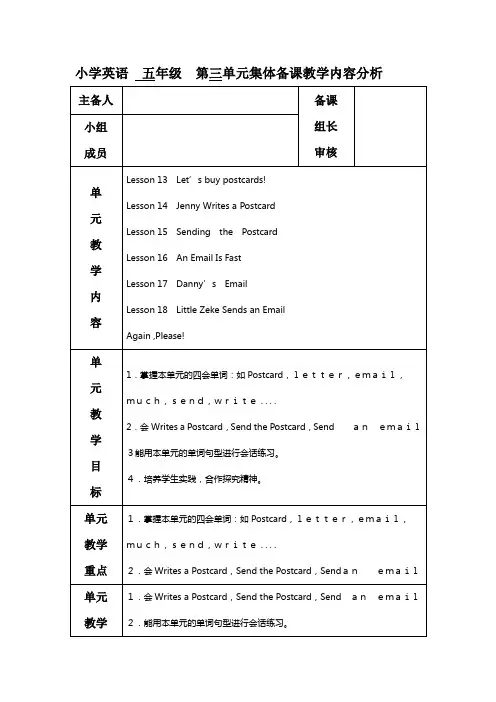
小学英语 五年级 第三单元集体备课教学内容分析主备人备课 组长 审核小组成员单元教学内容Lesson 13 Let ’s buy postcards!Lesson 14 Jenny Writes a PostcardLesson 15 Sending the PostcardLesson 16 An Email Is FastLesson 17 Danny ’s EmailLesson 18 Little Zeke Sends an EmailAgain ,Please!单元教学目标 1.掌握本单元的四会单词:如Postcard ,letter,email,much,send,write....2.会Writes a Postcard ,Send the Postcard ,Send an email3能用本单元的单词句型进行会话练习。
4.培养学生实践,合作探究精神。
单元 教学 重点 1.掌握本单元的四会单词:如Postcard ,letter,email, much,send,write....2.会Writes a Postcard ,Send the Postcard ,Send an email 单元 教学1.会Writes a Postcard ,Send the Postcard ,Send an email 2.能用本单元的单词句型进行会话练习。
难点课时安排8课时教导处审核意见五年级英语集体备课教案课题:Lesson13:Let’s Buy Postcards! 授课教师:主备人组长审核课时1课时成员上课时间教学目标1. 掌握下列四会词汇:postcard, letter, e-mail.2.在创设的情境中运用所学的知识,运用学到的日常用语简单地会话。
3.激发积极的情感因素,培养与人交流的能力。
教学重点四会词汇:postcard, letter, e-mail.运用学到的日常用语简单地会话教学难点运用学到的日常用语简单地会话教具应用教学过程二次备课S tep1. Warming-up(热身)Greeting: Hello, boys and girls. How are you? Step 2. Learning(新知)1.Postcard, letter, e-mailTalk about :(1)What do you write a letter on?(2)What does a postcard have?(3)Where can we buypostcards?2.Talk about: What do you write an e-mail on?(1) Play the audiotape. Ask some students to read the text.(2)IntroduceT: Look, here is a shop. It has many postcards. Which one do you like? Why? (Ask the students to answer.)T: Do you want to choose one to send to your family or friend? Introduce “send”with apicture. Who do you want to send them to?(3) Now, I’m a clerk. Can you buy it? (鼓励学生用How much ______?及I’ll take ______. 等句子进行对话,可再叫几名学生进行示范。
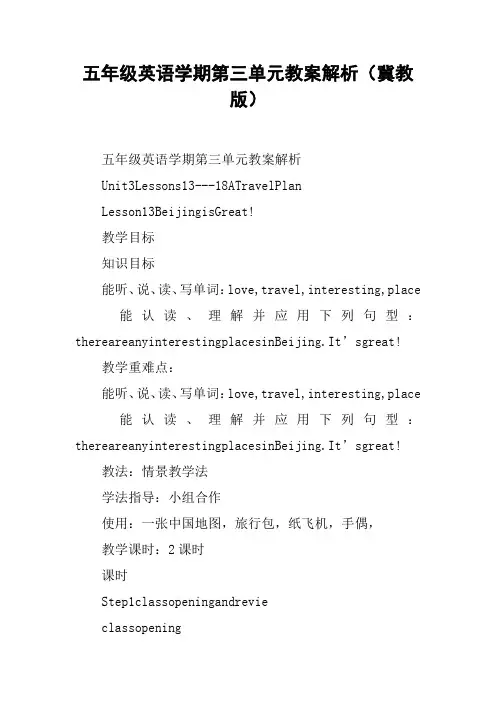
五年级英语学期第三单元教案解析(冀教版)五年级英语学期第三单元教案解析Unit3Lessons13---18ATravelPlanLesson13BeijingisGreat!教学目标知识目标能听、说、读、写单词:love,travel,interesting,place 能认读、理解并应用下列句型:thereareanyinterestingplacesinBeijing.It’sgreat!教学重难点:能听、说、读、写单词:love,travel,interesting,place 能认读、理解并应用下列句型:thereareanyinterestingplacesinBeijing.It’sgreat!教法:情景教学法学法指导:小组合作使用:一张中国地图,旅行包,纸飞机,手偶,教学课时:2课时课时Step1classopeningandrevieclassopeningGreeting[激情问候,营造宽松、民主、和谐的课堂氛围]Goodorning/afternoon,class!heredoelive?Revie通过问答操练复习上学期最后一个单元的重要词汇.复习学生已掌握的关于地点名称的词汇,提问:hereisthecapitalcityofourcountry?hatdoyounoaboutBeijing?Doyoulovetotravel?heredoyouanttogo?Step2NeconceptsDeonstrate用一张中国地图来示范Beijing.用一个手偶角色来演示trip。
例如:在黑板的一端画一圆圈来代表旅行的目的地。
教师组织手偶如下对话:手偶:Iagoingtoonatrip。
教师hereareyougoing?手偶:Iagoingto教师:Doyoulivein手偶:No,Ilivein。
教师:Doyoulovetotravel?手偶:yes.。
教师:heredoyoutogo?手偶:Usethestudentsbooandaudiotape与学生一起讨论有关北京的图片。
冀教版小学英语第五册第三单元教材分析与教学设计【单元教材分析】冀教版小学英语教材所设计的内容,一直围绕Li Ming、Jenny和Danny三位虚拟人物的学习和生活为故事主线。
本学期《Learning English》将要讲述Li Ming、Jenny和Danny到北京旅行的故事。
本单元中,Li Ming计划这次旅行并邀请Jenny 和Danny一起去。
本单元复习学生在第2册中已掌握的几种表示交通方式的词汇,增加一些和交通方式相关的新词汇和描述性词汇。
同时,通过这次对北京旅行知识的学习,学生可以增加其标准英语短语和词汇总量。
本单元内容按照故事主线展开,学生对故事情节有所了解,课文多以人物对话为载体,期间渗透重点句型,强调语言的功能性即语言的表达能力。
应以激发学生用英语与他人交流的兴趣,鼓励他们主动利用语言环境大胆实践。
【知识与技能目标】1.关键词汇和重点句型:(设计目标:学生可以读、写、说出并且听懂下列词汇)形容词:about形容词和形容词的比较级:fast, slow, faster, slower交通方式:airplane(plane), train,名词:Beijing(Peking), trip, hotel,动词:come, go, leave, arrive重点句型:(设计目标:学生可以说出并且听懂下列词汇)---May I/We______(动词)?---Yes, you may. (No, you may not.)---How far is_____?---It’s ____kilometres.2.可以进行简单描述北京景物。
(设计目标:本环节作为本课难点设立;突破方法:针对普通受众教师提示简单对话)3.根据所学词汇简单的谈论自己的一次旅行或制定一项简单的旅行计划。
(设计目标:本环节针对普通受众与顶尖受众相继展开;突破方法:教师展示提前准备好的计划进行讲解,并组织开展)【情感、策略、文化目标】1.本次设计旨在激发学生学习英语兴趣,锻炼学生口语表达能力,做到敢于开口、乐于实践。
15 Sending the postcards 教学设计一、教材分析本课选自冀教版小学英语五年级下册Unit 3 Wring Home.,本单元,孩子们将学习关于写信、明信片和电子邮件的词汇和表达。
本课处于本单元第三课,通过前两课,学生已经了解了和朋友及家人联系的三种方式,学习了书写明信片和信件的姓名地址,本课主要讲Danny和Jenny邮寄明信片的过程中发生的事,第一部分主要是怎样指路问路,指路问路四年级学生有过接触,所以在此更加深一下指路问路的应用。
第二部分讲述在邮局里发生的事情。
本课通过主要是让学生学会如何如何指路、问路,学会在生活中询问价钱。
本课篇幅不长,图文并茂,但其中包含着丰富的语言信息。
二、教学目标1、知识与技能目标:(1)能听懂、会说、认读、书写:turn、wrong(2)学生能认读、理解、运用下列基本句型结构:How much is/are…?Where is the post office?Turn left at…Do you need stamps?What are you doing?(3)学生能熟悉句子的连读。
2、学习策略目标:(1)养成听录音和跟读句子的习惯;(2)学习时集中注意力(4)积极与同学合作,共同完成任务;3、情感态度目标:(1)培养学习英语的兴趣和好奇心(2)培养学生积极与同学合作,共同完成任务的共赢意识。
4、. 文化意识目标: 感受明信片是朋友间、亲人间等联系的纽带,读后让人心生愉悦、倍感思念。
三、教学重点与难点1.教学重点:(1)能听懂、会说、认读并书写下列词汇:turn、wrong等。
(2)能认读、理解并运用下列基本句型结构:How much is/are…?Where is the post office?Turn left at…Do you need stamps?What are you doing?2.教学难点:结合具体的语境,灵活运用本课所学语言知识,在生活中学会应用指路、问路、询问价钱等英语语言。
小学英语第五册第三单元教学设计Unit Three What’s your favorite food?Let’s start Main scene Let’s chant A Let’s learn Group work1 Ss can listen say read and write the words tomatotofu green beans fish potato eggplant .Can read the words cabbage mutton pork and sentences What would you like for lunch? I’d like…2 Ss can use word cards to finish teamwork game, practice the new words.3 Ss can sing the song.1 New words tomato tofu green beans fish potato pork. Students are required to grasp these words and can use interrogative sentence What would you like for lunch? to practice the new words.2 Make the lesson easier.1 Hanging picture of Let’s chant2 Word cards3 Radio and tape1 Warm up(1) Show the picture about food then ask the students: What’s this? … Do you like it? … What would you like for lunch? …(2) Recite the words about food. Help the student to recall the food words they had learn.2 Preview(1) Put the hanging picture of Let’s start on the blackboard. Play a gassing game with students. Tell them like this: I’m yummy to eat. I’m yellow and long. I grow on tree My name begins with the letter as “bee”. What am I?(2) Ask the students to give the riddle an answer in Let’s start. Prepare to learn the new word tomat o.3 Presentation Let’s learn.(1) Learn new words in Let’s start.(2) Game. Say a fruit word then ask the student to give out it’s color quickly.(3) Listen to the tape of Let’s learn, read the new words after the radio.(4) Team work Spell the six new words, pete between groupsLet’s chantLearn the derry: What would you like for lunch?Group workPractice the new words by sentence: What would you like for lunch?I like…4 Consolidation and extension(1) To pile some riddles about food and fruits.(2) Require the student to do some investigation with their partner about the three meals in a day.Blackboard writing:Unit 3 What’s your favourite food?Pork tofu mutton potato cabbage tomato green beans fish tomato本课时要学的单词较多,cabbage eggplant mutton的单词没有较好的掌握.同学的运用旧句型what would you like for lunch? I’d like some tomatoes and mutton.来进展单词的训练学习.Unit Three What’s you favorite food?A Let’ try Let’s talk .Talk and match C Good to know1 Ss can understand and say: What do you have for lunch today? I have eggplant. Besides can use this sentence in true scene2 Ss can understand the hint words in Let’s try, tick or cross the picture in aordance with the massage form the tape.3 Ss can get some massage about Chinese culture in which the Chinese traditional food contained.1 What do you have for lunch today? And it’s answer I have…2 Difference use between sentence What would you like for lunch? What do you have for lunch today?3 Aording to the background culture of this lesson, teacher is required to introduce the Chinese food which have special meaning in the festival.1 Hanging picture or hand-draw picture of Good to know.2 Word cards (Nine new words and some old food words)3 Radio and tape31 Warm-up(1) Sing the song “What do you have for lunch?”(2) Ss make dialogues like:S1: What would you like for lunch /…? S2: I’d like …2 Preview(1) Teacher show the self-make investigation tables, “What do you have for lunch breakfast dinner…?(2) Let’s try Listen to the tape then ask Ss to give out their answer3 PresentationLet’s talk(1) Teacher use the answer of Let’s try to lead out sentence What do you have for lunch…?(2) Compare the two sentences: What would you like for lunch? What do you have for lunch today? Get Ss to know the new sentence. T and Ss use it to make dialogues together.(3) T asks one S to show out the food-word-cards,ask ”What do you have for lunch today?” “I have… what about yo u?”. Then change.(4) Listen the tape Let’s talkTalk and matchSs finish Talk and match with their partner.Good to knowT show out the hanging, introduce Chinese and other countries fare culture for Ss4 Consolidation and extension(1) Ask Ss to make a meal menu, municate with their friends(2) Ask Ss to do A Let’s talk Activity Book(3) Ask Ss to listen the tape part Let’s talk then read it out for their parents or friends.Blackboard writing:Unit 3 What’s your favourite food?I’m hungry.What do you have for lunch today?I have eggplant and tomatoes. What about you?I have onions and green beans.Unit Three What’s you favorite food?A Read and write Group work Let’s sing(1) Ss can listen say read and write the emphasis sentence: What do you have for lunch on Mondays? We havetomatoes, tofu and fish. And use the sentence to finish Group work(2) Ss can prehend the dialogue, and finish the exercises(3) Ss can understand and can sing the song What do you have for lunch?What do you have for lunch on Mondays? We have… That sounds goodHanging picture of this lesson Radio and tape A piece of School Menu1 Warm-up(1) Let’s singSing the song What do you have for lunch? Review and consolidation the maid sentences in part A(2) Daily oral English:A: What day is today?B: It’s Monday.A: What do you have for lunch?B: I have… What about you?A: I have…2 PreviewBroadcast the derry in Recycle 1grade 4 book 2(PEP). Ss sing after the radio3 presentationRead and write(1) Aording to the derry, Ss answer T’s question: What day is it today? What do you have on…? What do you havefor lunch on…? T show out the menu: Let’s see together, guide them to give out right answers.(2) Let the Ss to municate their menu with their group members, then ask tow or more Ss to summarize their group member’s menu in dialogue. After Ss summary, T says: That sounds good. Say it with gesture and expression, make Ss understand i t’s meaning.(3) Listen the tape Read and write. Finish the exercise below the text. Let them write the important sentences on their exercise book(4) Ask Ss to replace the maid words in thetext ,practice new sentences.Group work。
Lesson 3:What Do They Look Like?一、教学目标:1. 知识目标:(1)掌握并能简单运用四会单词glasses(复数概念), gray; 句型 I am taller/shorter than ____.(2)学完本课内容,学生能够用英语描述家庭成员的特征:比如年龄,头发,是否戴眼镜等。
2.能力目标:通过对话练习,让学生理解句意,并在情景中学习本课,培养学生自主学习的能力,获得与同学交流的方法。
在日常生活中能根据家庭成员的外貌特征展开简短的对话。
3.情感目标:通过本课学习让学生在感受美的同时学会尊敬他人,更重要的是在学习的过程中培养学生用英语交流的兴趣。
二、教学重难点:教学重点:glasses, gray的用法,以及区分gray和green 的发音;学生会用比较级I am taller/shorter than ____.教学难点:能用英语描述家庭成员的外貌特征。
三、教具学具:word cards,radio, pictures四、教学资源:自编歌谣How tall am I? How tall am I?I am 1.6, 1.6 meters tall.How tall is she? How tall is she?She is 1 meter tall.She is shorter than me.How tall is he? How tall is he?He is 1.7 meters tall.He is taller than me.五、教学过程:Step 1、Greeting:How are you today?I’m fine, thanks, and you ?I’m fine too.Step 2、Review:复习上一节课的家庭成员的单词。
Step 3、导入新课Part One:1、利用图片卷发、直发、长发、短发4种不同的发型,并涂上颜色复习staight hair, curly hair ,long hair, short hair以及blond,red,brown,black.并画上不同颜色的眼睛。
Lesson13 Beijing Is Great一、教材分析:本课是冀教版小学五年级英语上册第三单元的第一课,在这个单元中学生要学会如何思考、谈论、讲述和写作关于在自己国家旅行的事情。
李明的好朋友Danny 和Jenny来到中国了。
他们在中国开展了了不起的探索之旅。
学生要学习帮助他们谈论旅行方式、北京及其他地区景点的语言,还要学习如何制定旅行计划。
本单元结束时,学生应该能获得谈论和写出一次旅行的基本语言技能。
二、学情分析:五年级是小学英语学习的高年级阶段,知识更多更难,教师要努力在灵活多样生动有趣的基础上让学生扎实掌握知识,从而提高他们的英语综合素质。
三、教学目标:1.知识与技能目标1)能、听懂、认读并书写下列词汇:love,travel,interesting,place2)能认读、理解并能运用下列基本句子:There are many interesting place in Beijing. It is great.2. 学习策略目标学生将继续养成和提高前几册所介绍过的基本学习策略:要养成听录音和跟读句子的习惯;课上课下积极利用英语和他人交流;学习时要集中精力;主动问老师或者其他同学问题;通过联系在相关知识间建立关联;积极与同学合作,共同完成任务;制定简单的学习计划。
3.情感态度目标在经历旅行的过程中,学生感受到北京的伟大,增强对北京对祖国的热爱之情。
培养学习英语的兴趣和好奇心:找机会练习听力技巧;在日常生活中尽量模仿和使用英语。
4.文化意识:学生学会如何使旅行变成一次很好的文化学习的经历。
学会如何用英语向别人介绍中国美丽的景点。
四、教学重难点:教学重点:本课的单词love,travel,interesting,place基本句子There are many interesting place in Beijing. It is great.教学难点:能够就旅行展开话题,运用英语介绍北京。
英语说课稿我说课的内容是冀教版小学英语第五册Unit 3 Lesson 21 How Can We Go To Beijing? 本节课是一节有关比较级和交通工具的拓展课,这两项内容在前面的学习中学生都已经接触过,这节课主要是在内容上的丰厚和深化。
特别是李明和妈妈决定坐火车去北京一个话题为下册书学习在火车上的见闻做了一个铺垫。
这一单元所讨论的话题是旅游,这是学生们都比较喜欢的一个内容。
对于交通工具的讨论也能引起他们的兴趣,他们乐于学习和接受。
我将从学生感兴趣的地方入手,让他们积极参与到学习实践中来,使他们通过学习能获得学习英语的成就感和喜悦感。
依据《英语课程标准》提出的培养学生综合语言运用能力的目标要求,经研究教材和分析学生的认知特点,并根据实际教学情况,本课的教学目标确立为:知识目标:1.重点词汇及词组:airplane, train, fast, slow, faster than, slower than, take a bus, go by plane 2.重点句型:①A train is faster than a bus but slower than an airplane.②How can we go to Beijing?③ Let’s go to Beijing by plane.④ I want to take a bus.能力目标:1.能认读交通工具的名称。
2.可以说出几种表达交通方式的词组和句子。
3.会应用比较级去描述事物,进行口语交际。
情感目标:旅游是一件很有趣的事,但要提前为自己的出行做好打算。
选择交通工具是很重要的一个方面,要体谅父母挣钱的不容易,选择一种最适合的交通工具。
结合本课的教学目标以及学生的实际情况,本课的重难点确定为:重点:掌握本课的新单词及词组;会用比较级会话;能就交通工具和同学间进行交流。
难点:乘坐某种交通工具有不同的表达方式,本课出现了……go by plane 和……take a bus 两种,要明白不同词组的使用特点,能正确应用。
冀教版小学英语第五册第三单元教材分析与教学设计【单元教材分析】冀教版小学英语教材所设计的内容,一直围绕Li Ming、Jenny和Danny三位虚拟人物的学习和生活为故事主线。
本学期《Learning English》将要讲述Li Ming、Jenny和Danny到北京旅行的故事。
本单元中,Li Ming计划这次旅行并邀请Jenny 和Danny一起去。
本单元复习学生在第2册中已掌握的几种表示交通方式的词汇,增加一些和交通方式相关的新词汇和描述性词汇。
同时,通过这次对北京旅行知识的学习,学生可以增加其标准英语短语和词汇总量。
本单元内容按照故事主线展开,学生对故事情节有所了解,课文多以人物对话为载体,期间渗透重点句型,强调语言的功能性即语言的表达能力。
应以激发学生用英语与他人交流的兴趣,鼓励他们主动利用语言环境大胆实践。
【知识与技能目标】1.关键词汇和重点句型:(设计目标:学生可以读、写、说出并且听懂下列词汇)形容词:about形容词和形容词的比较级:fast, slow, faster, slower交通方式:airplane(plane), train,名词:Beijing(Peking), trip, hotel,动词:come, go, leave, arrive重点句型:(设计目标:学生可以说出并且听懂下列词汇)---May I/We______(动词)?---Yes, you may. (No, you may not.)---How far is_____?---It’s ____kilometres.2.可以进行简单描述北京景物。
(设计目标:本环节作为本课难点设立;突破方法:针对普通受众教师提示简单对话)3.根据所学词汇简单的谈论自己的一次旅行或制定一项简单的旅行计划。
(设计目标:本环节针对普通受众与顶尖受众相继展开;突破方法:教师展示提前准备好的计划进行讲解,并组织开展)【情感、策略、文化目标】1.本次设计旨在激发学生学习英语兴趣,锻炼学生口语表达能力,做到敢于开口、乐于实践。
2.注重创设情景,让不同层次受众有话可说,积极参与,鼓励学生创造性地使用语言,建立学习成就感和自信心。
3.让学生用英语对关于北京景物进行简单的描述,培养学生对首都北京的热爱。
冀教版小学英语第五册Unit3《Lesson 17 :Beijing Is Great!》教学设计【教材分析】本课是冀教版小学英语第五册第三单元《A Trip to Beijing》系列学习主题之一。
既是第二单元China内容的延伸,又是第三单元A Trip to Beijing故事的开端,具有承上启下的作用。
本课主要是讲Li Ming计划去北京旅游,他将邀请Jenny和Danny同行,并且带领我们重新复习了北京的一些著名景地。
本课内容丰富,围绕Li Ming的旅行计划展开,为学生创设想要和朋友去北京旅行的情境,让学生在交流中运用。
【学情分析】五年级学生对英语学习有浓厚兴趣,且英语口语表达能力较强,课堂中能灵活运用语言材料,能在虚拟的情景中进行真实的交流,语言流畅,有一定的创造力和感染力。
本课的内容不是很多,从话题本身分析,学生比较感兴趣,我们要善于抓住学生对去旅游的兴趣和热情,在情境中逐层的、有梯度的呈现新语言知识,进行有效的操练,使学生活学活用。
在课堂中,要求我们深入、巧妙的引导,从而使学生在交流中体验成功。
【教学目标】1.知识与技能a.学生能听、说、读、写单词:Beijing,trip, hotel。
b.学生能够运用本课句型I want to go on a trip to somewhere.I want somebody to come,too.进行简单对话。
c.学生能用英语简单描述北京并能运用相关北京图片进行交流。
2.学习策略采用以学生为主体的教学方式,例如,角色扮演法,分组合作法等针对教材内容的特点,考虑学生能力水平的高低和兴趣爱好的异同,鼓励他们自由组合,让所有学生都有锻炼的机会,都能进行有效地学习。
3.情感态度使学生感受到所学知识融汇到实际交往中的乐趣,从而激发学生学习英语的兴趣,培养学习英语的积极态度,使学生乐于合作参与,勇于表达。
4.文化意识通过天安门,故宫等名胜的介绍,让学生感受祖国历史悠久,文化底蕴丰厚,培养学生的民族自豪感与文明参观的公民意识。
【教学过程】Step1:Class opening and Review1.GreetingT:How are you today? How’s the weather?Ss:...(cool/hot/cold预设回答)(设计意图:让学生懂得,谈论天气,这是英国人标准的搭讪语言哦!)2.Reviewa. Guess(设计意图:游戏用以复习点地名称的词汇。
)T: Where do you buy?Ss:... (shop预设回答)T: Where do you live?Ss:... (A house\An apartment预设回答)T: Where do you eat?Ss:... (A restaurant预设回答)T: What is the capital city of China?Ss:... (Beijing预设回答)b. 利用图片复习学生已经掌握的关于地点名称的词汇(China,Tian’anmen Square,Palace Museum,capital city…)(设计意图:本环节为课前暖身,为了学生更快地融入英语语境,利用图片复习习得知识,为本课新知做铺垫。
)Step2 New ConceptsKey word:tripKey concepts:I want to go on a trip to Beijing.I want ...to come,too.1.导入新课:(出示课件,展示影像,创造语境。
)Beijing, Jing for short, is the nation's political, economic, cultural and educational center as well as China's most important center for international trade and communications. Together with Xian, Luoyang, Kaifeng, Nanjing and Hangzhou, Beijing is one of the six ancient cities in China. It has been the heart and soul of politics and society throughout its long history and consequently there is an unparalleled wealth of discovery to delight and intrigue travelers as they explore Beijing's ancient past and enjoy its exciting modern development.As the capital of the People's Republic of China, Beijing is located in northern China, close to Tianjin Municipality and partially surrounded by Hebei Province. The city covers an area of more than 16,410 square kilometers (6336 square miles) and has a population of 14.93 million people.Beijing is a city with four distinct seasons. Its best is late spring and autumn. But autumn is taken as the golden tourist season of the year since there is sometimes in the spring of recent years, a yellow wind. We suggest tourists visit Beijing during themonths of May, September, and October when people can enjoy bright sunshine and blue skies. An abundance of international class performances are presented in May. If you like winter, you will have other chances to appreciate another landscape of Beijing. After skiing in Beihai and viewing the snowy sights on West Hill, enjoying the steaming hotpot is the best choice, which is really the fun of tour in Beijing. Please keep warm and remember to bring your down garments and sweaters when you visit Beijing in the winter.How can one city boast so many phenomenal places? Beijing's long and illustrious history started some 500,000 years ago. It is here that the ancestors of modern Homo sapiens, Peking men, lived in caves. Records show that Beijing has been an inhabited city for more than three thousand years and has endured invasions by warlords and foreign powers, devastating fires, the rise and fall of powerful imperial dynasties and has emerged each time as a strong and vibrant city. For more than 800 years, Beijing was a capital city - from the Yuan Dynasty (1271 - 1368) to the Ming (1368 - 1644) and Qing (1644 - 1911) dynasties. Thirty-four emperors have lived and ruled the nation in Beijing and it has been an important trading city from its earliest days.Although now Beijing is a modern and fashionable city complete with a full 21st Century vitality, you can experience authentic Beijing life and become acquainted with 'old Beijing' by exploring its many teahouses, temple fairs, Beijing's Hutong and Courtyard and enjoy the Peking Opera. Add any or all of these to your Beijing tour and you will leave with a feeling of special appreciation in your heart for this ancient city that has truly seen it all and tells its story with matchless grace, charm and vigor.With the biggest central square in the world - Tian'anmen Square, the Forbidden Citythat is the largest and best-preserved imperial palace complex, a superbly preserved section of the Great Wall,as well as the largest sacrificial complex in the world - the Temple of Heaven, Beijing attracts both domestic and foreign visitors who all come to wonder at its century-old history and unique cultural relics.Dwelling too much on the historical past of Beijing may give tourists the false impression that it is little more than an ancient city in style but this is definitely not so! Strolling around Beijing, you'll find it has much in common with any other great metropolis elsewhere in today's world. There are towering skyscrapers; busy shopping malls and an endless stream of traffic that makes the city much the same as others. The most famous and popular commercial circles and commercial pedestrian streets are predominantly located near the Yansha Shopping Mall, Tiananmen and Wangfujing Street, Guomao Shopping Mall, Qianmen Street and Xidan Street, etc. However, although you will find multinational chains with their own brands to offer, nowhere else on earth will you find such a variety of gourmet Chinese restaurants offering the very best of the eight different styles of Chinese cuisine as well as western style dishes. Modern hotels abound, each offering the highest standards of service and convenience. After a day's Beijing tours, nighttime can hold other surprises for you. These can vary from traditional performances such as the Beijing Opera, acrobatics and martial arts to modern ones including concerts, ballroom dancing, pubs and clubs. Each and every one has its individual enchantment for the tourist. No description of our capital city is complete without mention of the friendly people who throng the streets. Everywhere you will encounter smiling faces and a warm welcome, especially from the children who love to say 'Hello!' All these things add up to truly make your visit a cultural experienceof a lifetime.T:Do you know where it is?Can you say something about Beijing ?Ss:...(学生可能只会用简单的句子进行描述,哪怕学生用中英文结合进行描述,果断鼓励之。